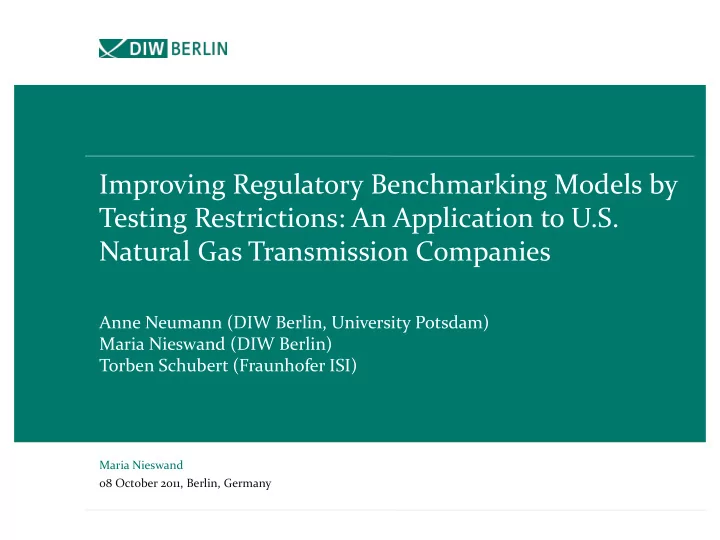

Improving Regulatory Benchmarking Models by Testing Restrictions: An Application to U.S. Natural Gas Transmission Companies Anne Neumann (DIW Berlin, University Potsdam) Maria Nieswand (DIW Berlin) Torben Schubert (Fraunhofer ISI) Maria Nieswand 08 October 2011, Berlin, Germany
0 Incentive Regulation Benchmarking ARegV The aim of the paper is to present an approach which makes deriving regulatory benchmarking models more objective, and therefore, improves the efficiency estimation. Modeling Technology Statistically Based DEA vs. SFA Model Specification Improving Regulatory Benchmarking Models by Testing Restrictions 2 Neumann, Nieswand, Schubert
Agenda 1 Regulatory Modeling of the Technology 2 Data 3 Methodological Issues 4 Theoretical Framework 5 Preliminary Results 6 Conclusions Improving Regulatory Benchmarking Models by Testing Restrictions 3 Neumann, Nieswand, Schubert
1 The Natural Gas Pipeline System Source: U. S. Department of Transportation, Pipeline and Hazardous Materials Safety Administration (PHMSA) Improving Regulatory Benchmarking Models by Testing Restrictions 4 Neumann, Nieswand, Schubert
1 Describing the Technology Environmental variables Transformation process Inputs Outputs Natural gas Transportation Number of CAPEX OPEX delivered service connections “classical” outputs of networks Source: El Paso/ Dominion Corporate Improving Regulatory Benchmarking Models by Testing Restrictions 5 Neumann, Nieswand, Schubert
1 Deriving the Regulatory Benchmarking Model Environmental variables Transformation process Inputs Outputs Natural gas Transportation Number of CAPEX OPEX delivered service connections Measured by • Total deliveries • Transmission system peak deliveries • Length of mains Improving Regulatory Benchmarking Models by Testing Restrictions 6 Neumann, Nieswand, Schubert
2 Data (unbalanced panel, obs=191, n=43, t=2003-2007) Table: Descriptive Statistics Variable min 1 st quartile median mean 3 rd quartile max Opex 315 8,983 24,510 48,620 68,970 285,600 [in 1,000 Euro] Opex 268 7,776 20,590 42,420 60,010 244,300 [in Euro, 2003 prices] a Total deliveries 20,120 143,600 363,000 507,000 742,200 3,138,000 [in 1,000 Dth] Peak deliveries 122 585 1,303 1,614 2,283 7,124 [in 1,000 Dth] Length of mains 80 364 1,402 2,379 3,915 9,627 [in miles] Note: a As deflator the producer price index for utilities is used (Source: Bureau of Labor Statistics Data). Source: FERC Form No. 2 Improving Regulatory Benchmarking Models by Testing Restrictions 7 Neumann, Nieswand, Schubert
3 Methodological Issues Some Drawbacks of DEA??? Implications and Approaches!!! • No statistical noise • Sensitive to extreme values • Outlier detection (also based on statistical tests) • Robust nonparametric frontiers (order-m, order- α ) • No functional form of • No misspecification • No statistical tests on coefficients? technology • Restriction tests • Curse of dimensionality • Meaningful results require lots of observations • (slow rate of convergence) Increase number of observations: pooling data test on technical progress • Reduce the number of variables: exclude/ aggregate variable restriction tests • Robust nonparametric frontiers (order-m, order- α ) Improving Regulatory Benchmarking Models by Testing Restrictions 8 Neumann, Nieswand, Schubert
4 Linear Program Input-oriented DEA with VRS The question Improving Regulatory Benchmarking Models by Testing Restrictions 9 Neumann, Nieswand, Schubert
4 Finding a Statistically-based Answer I The hypothesis: Estimate the model under the different model specifications and obtain From theory it holds And therefore Improving Regulatory Benchmarking Models by Testing Restrictions 10 Neumann, Nieswand, Schubert
4 Finding a Statistically-based Answer II obtain a test statistic and or critical values depending on the critical values critical values vary with subsample’s size Improving Regulatory Benchmarking Models by Testing Restrictions 11 Neumann, Nieswand, Schubert
5 Preliminary Test Results • Model specification: x optimal subsampling size • Varying subsample size 95%quantile as a function of m • Varying 95%-quantile • Varying critical values • Varying decisions w.r.t. • Reject if test statistic > critical value • For optimal subsample size of 38 • Critical value is about 0.13 observed value of test statistic • DO NOT REJECT Improving Regulatory Benchmarking Models by Testing Restrictions 12 Neumann, Nieswand, Schubert
6 Conclusions • Objectify the regulatory benchmarking model selection • For our sample (U.S. natural gas transmission companies) • Output variables total deliveries and transmission system peak deliveries can be included as an aggregate • Variables are not really individually relevant • Reduce dimensions of the model specification • Improve estimation (because the rate of convergence increases with less dimensions) • Can easily be adopted in regulatory practice Improving Regulatory Benchmarking Models by Testing Restrictions 13 Neumann, Nieswand, Schubert
Thank you for your interest. Questions and comments are welcome! DIW Berlin — Deutsches Institut für Wirtschaftsforschung e.V. Mohrenstraße 58, 10117 Berlin www.diw.de Maria Nieswand mnieswand@diw.de
B From Questioning to (Statistically) Answering The hypothesis: The efficiency estimator under the different model specifications: The consequence: The test statistic: Improving Regulatory Benchmarking Models by Testing Restrictions 15 Neumann, Nieswand, Schubert
Recommend
More recommend